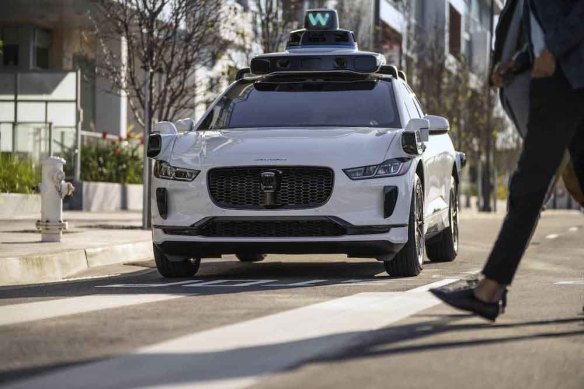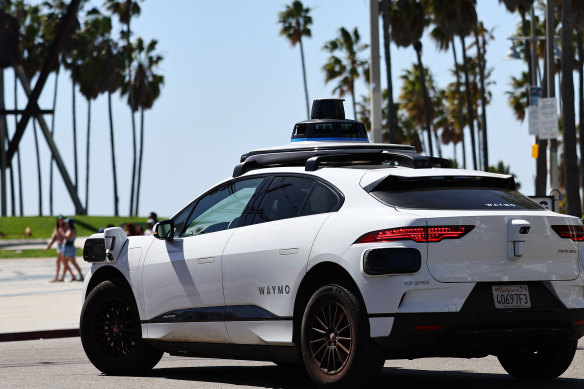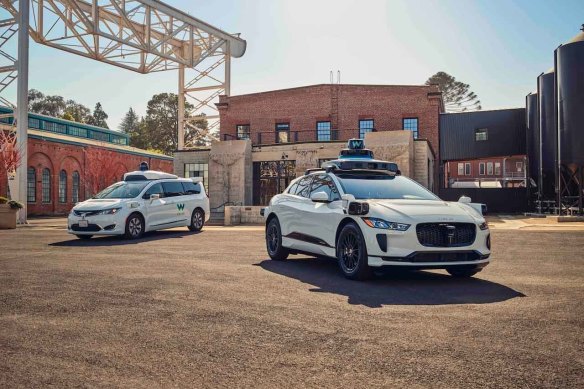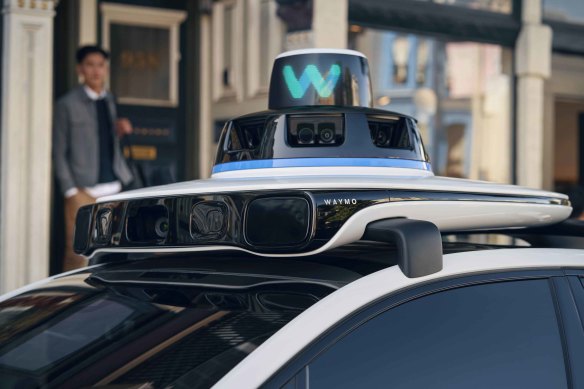I rode San Francisco’s new driverless taxis, here’s how it went
Would you let an AI robot take you for a spin around the block? That’s essentially what I did on a recent trip to the United States.
When I booked a two-night stopover in San Francisco in mid-July, an itinerary overstuffed with restaurants, bakeries, museums, op-shops and other must-dos began to take shape. But there was really only one non-negotiable: to ride in a self-driving car.

Waymo recently expanded operations into the San Francisco Peninsula.Credit: Waymo
Waymo One’s fully autonomous, all-electric cars – part of Google’s parent company, Alphabet – have been operating commercially in the city since late 2022, scaling up the service over time. The company now has self-driving vehicles in Los Angeles, Austin and Phoenix, and has even expanded operations into the San Francisco Peninsula.
Until recently, anyone who wanted to ride in one of these robotaxis was required to download an app, register on Waymo’s waitlist (which I did back in May) and patiently wait for an invitation code.
Just when I thought I had missed my window, on June 25 the company announced it was opening to anyone in San Francisco and Metro Phoenix with a Waymo One app. No more waitlists, or exclusive codes; just download the app and add your credit-card details to start riding immediately.

Waymo launched self-driving vehicles in Los Angeles in March 2024.Credit: Getty Images
Even before the update, the autonomous ride-hailing service’s fleet of gleaming white Jaguar I-Paces had catapulted into a highly sought-after tourist attraction. For visitors, a ride in one of these futuristic cars is an attraction as novel and uniquely Bay Area as, say, Alcatraz Island or Golden Gate Park. The driverless vehicles – and their conspicuous spinning black top hats (each with 29 mounted cameras and 10 radar sensors) – seem to be all over the city, prowling the streets, as prolific in this pocket of the world as Karl the Fog.
Once you arrive in San Francisco, you can add payment details to the Waymo app. Then, just like Uber or Lyft, you’re able to order robotaxis any time you like.
But while Waymos are nothing new to this town, they’re new enough to still be a spectacle to passersby – though not always in a fun way. While acutely attuned to their physical surrounds, the robotaxis are, to paraphrase one Los Angeles Times critic, totally tone-deaf to social environs – a fact we quickly learn on approach to our first Waymo.
Our hotel borders the Tenderloin district, a neighbourhood known for its high rates of homelessness and street crime – so much so, that our hotel offers complimentary car services for guests. The Waymo designated pick-up spot is in full view of a homeless camp – which feels insensitive, if not downright offensive to the inhabitants.

The robotaxi company launched to anyone with an app in June 2024.Credit: Waymo
Dolled up for a night out, we suddenly feel silly and overdressed. My sister and I approach the vehicle cautiously but quickly – I’m prompted to unlock the door with a button on the app and we both shuffle into the back seat.
Unaware of its faux pas, the Waymo launches into its “first-timer” spiel over the speakers as we pull away, an invisible driver turning the steering wheel while we stifle squeals of excitement.
“This may be futuristic, but you need to buckle up as always,” the voice booms. “So keep your seatbelt fastened, please. We’ll do all the driving, so please don’t touch the steering wheel or pedals during the ride.”

The Jaguar I-Paces feature spinning black top hats with 29 mounted cameras and 10 radar sensors.Credit: Waymo
“We may use interior cameras,” it continues, “but our microphones are only on when connected to rider support, so sing your heart out – we can’t hear you. You can also use the app or passenger screen to speak to a rider support agent.”
The induction also includes instructions on how to customise music preferences in the app – riders can choose from a range of iHeartRadio genres, including pop, EDM, jazz and R&B.
“In the rare case of an emergency, please keep your seatbelt fastened and remain in the car unless there’s an urgent need to exit – rider support will connect with you and provide assistance.”
It concludes: “Finally, relax and thank you for riding with us.”
Inside, there are phone-charging stations, and a passenger screen in the front seat displays a GPS radar map at all times.
I’m immediately struck by the comfort and smoothness of the ride – as we navigate San Francisco’s famously hilly topography, I find myself instinctively gasping or muttering “oh my god” under my breath as we traverse the steep inclines and ridges followed by sudden drops. The Waymo doesn’t slow to see what’s ahead – after all, it has a radar sensor and can anticipate every move around every corner, uninhibited by blind spots or surprises.
We watch in suspense as a cyclist pulls in front – Waymos can clock bicyclists, pedestrians and other obstacles on the radar well before we do, giving them right of way and approaching with an uncommon patience and gentle ease.

The historic cable cars may have some competition.Credit: Getty Images
The typical jolts and jerkiness we’re accustomed to in Uber rides are noticeably absent. Robotaxis may not have an awareness around social cues and norms, but they’re also not susceptible to emotional road-raging or reckless behaviour, not fuelled by fear or ego in the way humans are prone to be – they just follow road rules to the letter of the law. It fanatically maintains the speed limit, like a deeply sensible friend on designated-driver duties.
The driverless car company maintains its vehicles are safer than actual human drivers, despite some of the headlines. In August, nearly a month after my visit, Waymo was in the headlines again when San Francisco residents complained the fleet of driverless vehicles were interrupting their sleep in the South of Market neighbourhood, where the cars were relentlessly honking at each other in the early-morning hours. The company released a statement saying the issue had been caused by the software designed to prevent slow-moving crashes – a teething problem, that has since been addressed.
Ubers are generally still cheaper than Waymo, though not significantly – we find ourselves ordering a Waymo again the following day.
After wandering down to Fisherman’s Wharf, hoping to catch one of the city’s historic cable cars, we learn there’s a 40-minute wait. My sister doesn’t even have to say it: I reach for the app.
The robotaxi only takes eight minutes to arrive, and as it pulls up next to the snaking cable car queues at Powell and Market, we become a temporary tourist attraction. Children point and stare in astonishment at the empty front seats, while others film on their devices, and some bystanders yell questions at us. ”What is this? How can we get one?”
On approach, I stand too close to the car’s boot and the trunk pops open automatically – already flustered with people watching our every move, this sends me into a panicked confusion. “Oops! Just let me close it,” I blather, as my sister climbs in and I fumble around for a button.
I have no memory of closing the boot – or getting into the car – though I must have succeeded. As we pull away from the group of gawking pedestrians, our Waymo is of course oblivious to its scene-stealing antics, its pace reliably smooth and steady as ever. Like its human riders, it’s not quite perfect, and yet, I can’t help but think we could learn a thing or two from Waymo.
The writer traveller at her own expense.
Sign up for the Traveller Deals newsletter
Get exclusive travel deals delivered straight to your inbox. Sign up now.